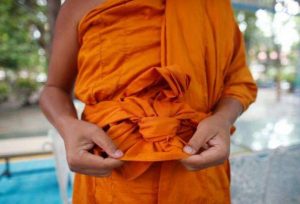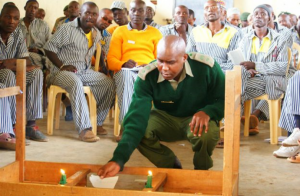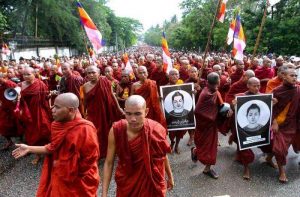
The Smart Pagoda is a community development project created in Thailand by Buddhist monk Phra Sangkom Thanapanyo Khunsiri. The project was initiated in collaboration with civil society leader Prof. Wiwat Salyakamthorn, founder of the Agri-Nature Foundation and Self-sufficiency Economy Institute, who worked with King Bhumibol Adulyadej (r. 1946–2016) for 17 years as director of the Special Committee to Coordinate Royal Projects. In addition to its role as a Buddhist place of worship, the Smart Pagoda is a demonstration site for the following six initiatives:
1. Surrounding environment: regeneration of the water table/watershed by building water tanks—reforestation and rehabilitation of land based on the royal development principle of 30 per cent water resource, 30 per cent agriculture, 30 per cent forest cover, and 10 per cent housing.
2. Education for ecology and the Dharma: simultaneous establishment of an eco-school in which children learn about practical livelihood, environment, and sufficiency values.
3. Sufficiency economy: planting “three trees for four benefits” for food, sufficiency and commerce, housing, environmental integrity; eco-commerce development at school.
4. Community development: adults influenced by children’s education and celebrities in the promotion of building water tanks.
5. Eco-Temple: The Smart Pagoda and adobe housing as a means of embodying and promoting ecological values, sufficiency lifestyle, and spirituality.
6. Energy sector: installation of solar panels at temple guesthouse to embody and promote ecological values, sufficiency lifestyle, and spirituality.
Asia has many active ecoDharma initiatives, but cross-pollination with Western Buddhists is still a work in progress. In this column, I’ll explore some of the Asian projects associated with the Interfaith Climate and Ecology Network (ICE) of the International Network of Engaged Buddhists (INEB).
EcoDharma and the Four Noble Truths
The ICE was established in 2012 with a mandate to engage with suffering in the world as it now manifests: the First Noble Truth. In this context, the focus is on environmental degradation from the modern industrial development process, such as deforestation and the destruction of numerous habitats. A critical aspect of this process has been the economic marginalization of rural communities, and the exploitation and destruction of their environments for the creation of massive energy projects to fuel high-consumption urban lifestyles—e.g., massive dams that have relocated hundreds of thousands of people, and nuclear power plants that endanger the entire fabric of life in rural areas.
Aligning with the Second Noble Truth, INEB members have examined the environmental suffering in their regions to uncover its structural and cultural causes. Aligning with the Third Noble Truth, they have articulated alternative visions based on Buddhist teachings, and aligning with the Fourth Noble Truth, they have developed activities and projects to realize these visions.
A holistic vision: design and seed-planting
The overarching goal of the Interfaith Climate and Ecology Network is to develop ecological human communities that are sustainably interconnected with the natural environment through the community center of a religious facility/temple.
The holistic approach arises out of the multi-dimensional nature of the challenge: material, relational, and spiritual. It involves a comprehensive integration of: 1) an ecological temple structure and energy system; 2) economic sustainability; 3) the surrounding environment; 4) engagement with community and other regional groups such as civil society, business, and government; and 5) the development of spiritual values and teachings on the environment, or ecoDharma.

Given the vast differences in challenges faced by different communities, ICE sees its role as planting seeds by modeling projects with different types of engagement—a bottom-up, hands-on approach. In that spirit, their ideal design criteria for an eco-temple community include: 1) a sufficiency economy; 2) education for ecology and the Dharma; 3) eco-temple structures; 4) positive integration with surrounding environments; 5) community development; and 6) an energy sector interface.
This is quite a different approach to that taken by many Western Buddhist ecoDharma teachers and organizations, where the focus is much more on personal transformation. For INEB, structural change, institutional programs, and community development are centered within the mandala of Buddhist practice.
There was much more Western Buddhist involvement with INEB in the 1990s, but that has progressively diminished as second-generation North American and European Buddhist teachers have looked inward in their own unique understanding of how to build their sanghas, and rejected many of the cultural forms of the Asian traditions of their Dharma elders. While this is a natural and valuable evolution in many regards, it also contains the risk of throwing out the baby with the bathwater.
COVID-19 and a change of focus in 2020
The advent of pandemic lockdowns in March 2020 had a serious impact on INEB, whose primary mode of interaction was based on in-person networking. Many of the network’s sharing and study activities came to a complete halt, including their planned international gathering in Myanmar, scheduled for November 2020.
However, the core Eco-Temple sangha remained in close contact, and in the second half of 2020, INEB held a number of intensive Zoom sessions to re-envision the strategic integration of the network’s activities. At the end of this process, the network was able to develop a new layered system of integrated activities.
The new strategy articulates three layers of action:
- • Small sphere: local ecology through food security and waste management for home & community
- • Medium sphere: community and regional ecology through land restoration and integrated farming
- • Large sphere: regional and trans-national ecology: wildlife corridors, forest preservation, and biodiversity
. . . along with two cross-sector dimensions, each with two aspects:
- • Cross sector technology I: clean, sustainable energy
- • Cross sector technology II: ecological architecture through compressed stabilized earth blocks (CSEB) and bamboo technology
- • Cross sector social enterprise I: eco-products
- • Cross sector social enterprise II: community tourism and working holiday

The Eco-Temple website features many web links to more than 15 individual projects illustrating specific applications of this new strategy. Locations range across Bangladesh, China, India, Japan, Myanmar, South Korea, Sri Lanka, Thailand, Vietnam, and even the UK. The Smart Pagoda described above is just one of them. I highly recommend going deeper into the many projects by following the links below.
What is striking about this list is that most of the projects are in areas of extreme poverty, often in rural locations where self-sufficiency is paramount. Much of their focus is on social enterprise and community development. At the other end of the spectrum, the projects in China, Japan, and South Korea are more focused on the implementation of solar energy in urban settings.
There is potential for greater collaboration with Western Buddhists, particularly in the medium sphere of land restoration and in the large sphere of forest preservation and biodiversity. In both of these spheres, initiatives in regenerative design are greatly needed in North America and Europe too.
Through the religious center/temple, the Eco-Temple movement can contribute greatly to the critical need for education and the practice of inner ecology, while connecting that to outer ecological activities, such as community mobilization on environmental issues, right livelihood, and, foremost for this project, the establishment of a zero-waste, clean energy temple structure integrated into the local environment. From such a movement, religious communities can have a progressive role in the wider movements for ecological design and post-industrial societies, which is critical to the immediate global environmental crisis.
A new conference
INEB will be holding its 21st Biennial Conference—its first in-person conference after the pandemic—in Chennai, India, at the end of November 2024, in association with the Tamil Buddhist Society. Here is the draft schedule:
- • 25–27 November: a hands-on workshop at the Sukhavati Eco-Temple
- • 28–29 November: engaged buddhist workshops on gender equality and social inclusion, climate change, child protection, and marginalized and inclusive communities
- • 30 November: Visits to Buddhist heritage sites and the Sukhavati Eco-Temple
- • 1 December: Public symposium
- • 2–3 December: INEB AC/WC meeting
See more
Related features from BDG
Walking a New Path
The Barre Center for Buddhist Studies: EcoDharma Beacon
One Earth Sangha: Celebrating 10 Years of EcoDharma
Touching the Earth: An Ecodharma Retreat
How Buddhists Can Embrace the Degrowth Movement
Calm
Buddhist Voices in the Climate Crisis: Welcome to the Anthropocene














